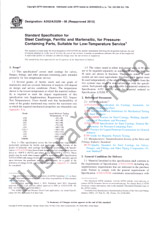Potřebujeme váš souhlas k využití jednotlivých dat, aby se vám mimo jiné mohly ukazovat informace týkající se vašich zájmů. Souhlas udělíte kliknutím na tlačítko „OK“.
ASTM E1014-12(2021)
Standard Guide for Measurement of Outdoor A-Weighted Sound Levels
Přeložit název
NORMA vydána dne 1.1.2021
Informace o normě:
Označení normy: ASTM E1014-12(2021)
Datum vydání normy: 1.1.2021
Kód zboží: NS-1017017
Počet stran: 6
Přibližná hmotnost: 18 g (0.04 liber)
Země: Americká technická norma
Kategorie: Technické normy ASTM
Kategorie - podobné normy:
Anotace textu normy ASTM E1014-12(2021) :
Keywords:
A-weighted sound levels, community noise, outdoor noise, noise sampling,, ICS Number Code 17.140.01 (Acoustic measurements and noise abatement in general)
Doplňující informace
| Significance and Use | ||||||||||
|
4.1?There are numerous situations for which outdoor sound level data are required. These include, but are not limited to, the following: 4.1.1?Documentation of sound levels before the introduction of a new sound source (for example, assessment of the impact due to a proposed use). 4.1.2?Comparison of sound levels with and without a specific source (for example, assessment of the impact of an existing source). 4.1.3?Comparison of sound levels with criteria or regulatory limits (for example, indication of exceedence of criteria or non-compliance with laws). 4.2?This guide provides a means for selecting measurement locations, operating a sound level meter, documenting the conditions under which the measurements were performed, and recording the results. 4.3?This guide provides the user with information to (1) make and document the sound level measurements necessary to quantify relatively steady or slowly varying outdoor sound levels over a specific time period and at specific places and (2) make and document the physical observations necessary to qualify the measurements. 4.4?The user is cautioned that there are many nonacoustical factors that can strongly influence the measurement of outdoor sound levels and that this guide is not intended to supplant the experience and judgment of experts in the field of acoustics. The guide is not applicable when more sophisticated measurement methods or equipment are specified. This guide, depending as it does on simplified manual data acquisition, is necessarily more appropriate for the simpler types of environmental noise situations. As the number of sources and the range of sound levels increase, the more likely experienced specialists with sophisticated instruments are needed. 4.5?This guide can be used by individuals, regulatory agencies, or others as a measurement method to collect acoustical data for many common situations. Criteria for evaluating or analyzing the data obtained are beyond the scope of this guide. 4.6?Note that this guide is only a measurement procedure and, as such, does not address the methods of comparison of the acquired data with the specific criteria. No procedures are provided for estimating or separating the influences of two or more simultaneously measured sounds. This guide can be useful in establishing compliance when the measured data are below a specified limit. 4.7?Section 8.2.1 outlines a procedure that can be used for a survey of the site boundary; paragraph 8.2.2 for a survey of specified monitoring points; and paragraph 8.2.3 for determining the location and magnitude of maximum sound level. |
||||||||||
| 1. Scope | ||||||||||
|
1.1?This guide covers the measurement of A-weighted sound levels outdoors at specified locations or along particular site boundaries, using a general purpose sound-level meter. 1.2?Three distinct types of measurement surveys are described: 1.2.1?Survey around a site boundary, 1.2.2?Survey at a specified location, 1.2.3?Survey to find the maximum sound level at a specified distance from a source. 1.3?The data obtained using this guide are presented in the form of either time-average sound levels (abbreviation TAV and symbol L1.4?The values stated in SI units are to be regarded as standard. No other units of measurement are included in this standard. 1.5?This standard does not purport to address all of the safety concerns, if any, associated with its use. It is the responsibility of the user of this standard to establish appropriate safety, health, and environmental practices and determine the applicability of regulatory limitations prior to use. 1.6?This international standard was developed in accordance with internationally recognized principles on standardization established in the Decision on Principles for the Development of International Standards, Guides and Recommendations issued by the World Trade Organization Technical Barriers to Trade (TBT) Committee. |
||||||||||
| 2. Referenced Documents | ||||||||||
|




 Cookies
Cookies
